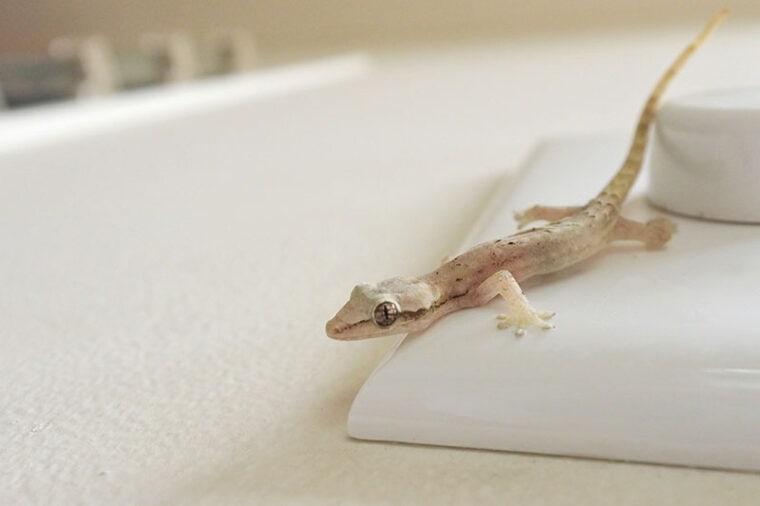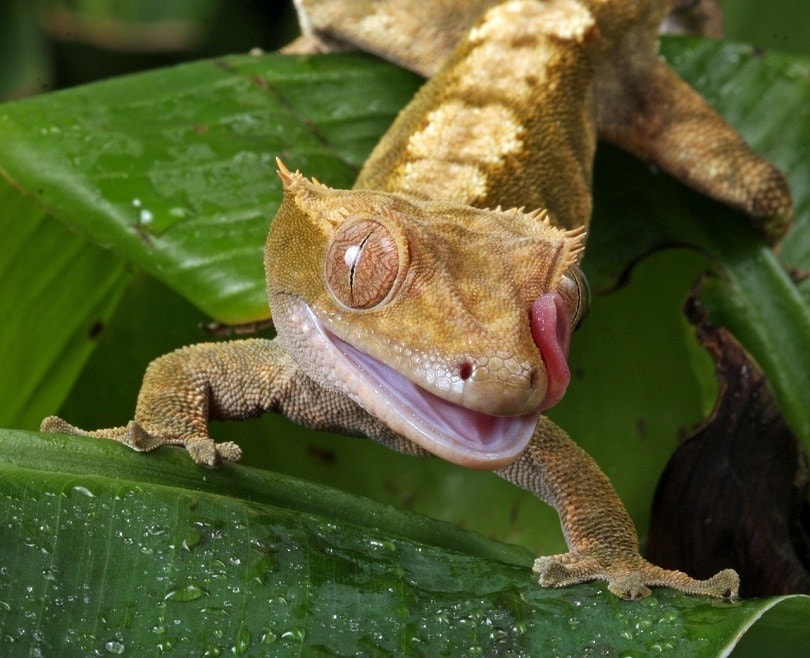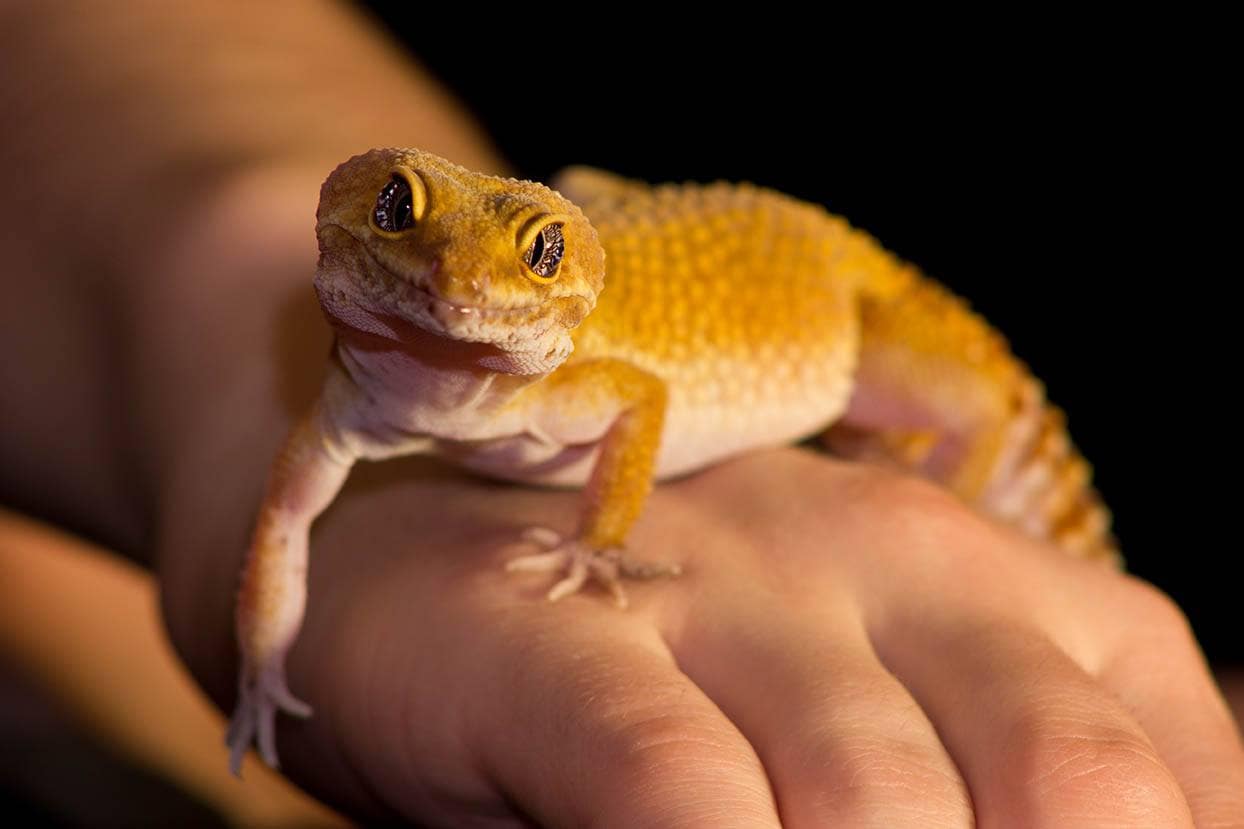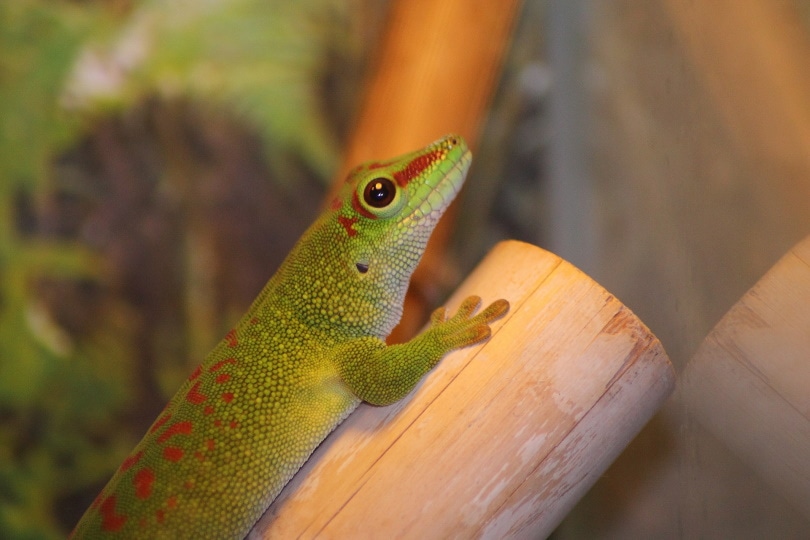
Mourning geckos are among the most widely distributed reptiles in the world. Small in size and delicate, mourning geckos are often kept as feeder pets or in colonies for display.
These reptiles are easy to care for, but it’s important to provide the proper environment for your mourning gecko. You also have to prepare for some of the unique qualities of mourning geckos, such as their spontaneous breeding.
Quick Facts about Mourning Geckos
| Species Name: | Lepidodactylus lugubris |
| Common Name: | Mourning gecko |
| Care Level: | Easy |
| Lifespan: | 10 years |
| Adult Size: | 3.5 to 4 inches |
| Diet: | Nectar, fruit, insects |
| Minimum Tank Size: | 5 gallons per 2 geckos |
| Temperature & Humidity | 70-85°F & 60-90% |

Do Mourning Geckos Make Good Pets?
Yes! Mourning geckos are among the easiest types of reptiles to keep, even for beginners. They’re also a rare exception in the reptile world in that they can be kept in colonies with certain other species. Mourning geckos are tolerant of beginner mistakes, but it’s key to provide the best possible husbandry for these critters to thrive.
Appearance
Mourning geckos are similar to other geckos and have varied colors from top to bottom. They’re usually brown with light tan but may have distinctive markings in zigzag or chevron-like patterns with a stripe that runs from nostrils to ears.
How to Take Care of a Mourning Gecko
Habitat, Tank Conditions & Setup
Tank
Mourning geckos do well in colonies of two or three individuals to as many as nine as long as they have the appropriate amount of space. A small colony requires a 12”L x 12”W x 18”H (30L x 30W x 45H cm). This is about 10 gallons. If you keep more than three geckos, you need another five gallons per two geckos.
Lighting
Mourning geckos are cathemeral, which means that they are active sporadically throughout the day and night. Wild mourning geckos will bask during the day, and their captive counterparts will bask if given a UVB light. Ideally, choose a low-output UVB bulb that’s the length of the enclosure, which creates a light gradient and plenty of basking sites for the whole colony.
Heating (Temperature & Humidity)
Mourning geckos have a wide distribution in tropical and subtropical areas. They need a temperature gradient to thermoregulate properly.
The basking area, which should be positioned near the top of the enclosure, falls between 80–85°F (26–29°C). The cool area near the bottom should be 70–75°F (21–24°C). The night temperature drop should be 65–72°F (18–22°C). It’s vital that the temperatures stay within these ranges to avoid health problems like stress and heat stroke.
For humidity, the terrarium should be 60% to 70% ambient humidity with high-humidity areas that reach 80% to 90%. This can be done with misting, as long as your terrarium has the proper ventilation to allow the moisture to escape. Tap water is ideal because it provides added minerals as the geckos lap up water droplets. Avoid distilled or filtered water for misting.
Substrate
For substrate, these geckos need substrate types that support their humidity needs, such as orchid bark. One of the best options is a bioactive enclosure, which is time-consuming and expensive to set up but offers self-cleaning and a healthy, naturalistic habitat.
| Tank Recommendations | |
| Tank Type | 10-gallon low for 2–3 geckos, 5 gallons per additional 2 geckos |
| Lighting | Low-output UVB |
| Heating | Low-wattage incandescent bulbs (15–25W) for a basking spot |
| Best Substrate | Orchid bark |
Feeding Your Mourning Gecko
Mourning geckos are omnivores and thrive on a diet of fruit, pollen, and insects. You can provide your gecko with a commercially prepared crested gecko diet supplemented with insects and calcium plus D3 powder. Appropriate feeder insects may include flightless fruit flies, small crickets, bean beetles, rice flour beetles, soldier fly larvae, and extra-small superworms.
| Diet Summary | |
| Fruits | 40% of diet |
| Insects | 60% of diet |
| Supplements Required | Calcium + D3 |
Keeping Your Mourning Gecko Healthy
Mourning geckos are prone to many of the same health conditions as other captive lizard species. Fortunately, many of these conditions are preventable with proper husbandry, diet, and veterinary care.
Common Health Issues.
Stomatitis, known as mouth rot, is common in mourning geckos. It appears as redness, swelling, or a cottage-cheese-like discharge from the mouth.
Parasitic infections are also seen in captive geckos, especially if they’re kept in poor conditions. Skin parasites appear as inflammation or rashes, while internal parasites often cause digestive issues like poor appetite and weight loss. It’s crucial to diagnose these conditions quickly and quarantine new or sick geckos to prevent transmission to the entire colony.
Metabolic bone disease (MBD) is a condition caused by low UVB exposure or a deficiency in calcium or vitamin D3. As it progresses, geckos may have curved limbs, poor appetite, a loss of coordination, and seizures. This is preventable with proper diet and lighting.
Though mourning geckos get along well with others, they can suffer injuries from a fight with other geckos. They can grow their tails back, but wounds or significant blood loss can be life-threatening.
Lifespan
With proper care, the mourning gecko can survive up to 10 years in captivity. Some keepers have even reported individuals living as long as 15 years. This is a strong contrast to the wild, where mourning geckos are desirable small prey for birds, snakes, and larger lizards.
Breeding
Mourning geckos are easy to breed since they’re all female and reproduce asexually through parthenogenesis. They don’t need males to reproduce, and the offspring are basically clones of their mothers.
If you want to breed your gecko, you will need a breeding tank that’s suitable. They will begin to lay eggs around 9–10 months old. They lay one or two eggs in 4- to 6-week intervals. These eggs hatch about 2 to 6 months after they’re laid.
Are Mourning Geckos Friendly? Our Handling Advice
Unlike some reptiles, mourning geckos are best as display pets that aren’t handled. They are incredibly small and delicate, not to mention fast, so it’s easy for them to end up loose during handling. Some keepers manage to condition their geckos to avoid bolting, but it takes time and it’s not foolproof.
In general, handling should be limited to necessity, such as when you’re transferring geckos from their terrarium to a holding terrarium for cleaning or taking them to the vet. Aside from the risk of bolting, they can get stressed out from regular handling, and it can impact their health.
Shedding & Brumation: What to Expect
A healthy mourning gecko will shed regularly as it grows, which is usually about every five weeks in adulthood. This is a good way to monitor health, as a sick gecko will not shed properly.
Typically, the shedding process will be complete in about 24 hours, but it could take longer if they experience some retained shed. It’s important to leave your gecko alone during its shed to avoid excess stress. Geckos usually eat their shed skin as it comes off, which provides protein and nutrients while hiding their existence from predators.
Mourning geckos do not hibernate (brumate). They’re active throughout the year.
How Much Do Mourning Geckos Cost?
Mourning geckos are inexpensive to purchase. Hatchlings run about $30, while adults run about $50. You may see higher prices for geckos with different colors or markings. Remember that you should keep geckos in a colony, so you will need to pay for multiple geckos.
In addition to the purchase price, you will need supplies for your mourning gecko before you bring it home. With the tank, substrate, décor, lighting, temperature and humidity gauges, and food, you will be looking at $300 to $500 in initial costs.
Care Guide Summary
| Mourning Gecko Pros | Mourning Gecko Cons |
| Live in colonies | Better for display than handling |
| Easy to care for | Prone to escape |
| Minimal space requirements | Unwanted offspring |
Summary
Mourning geckos are cute pets that are easy to care for, even for beginners. One of the few reptile species that coexist with others, mourning geckos can be kept in colonies with other geckos and certain species. They will breed on their own, however, and are better as display pets than for handling.
Featured Image Credit: ChameleonsEye, Shutterstock









